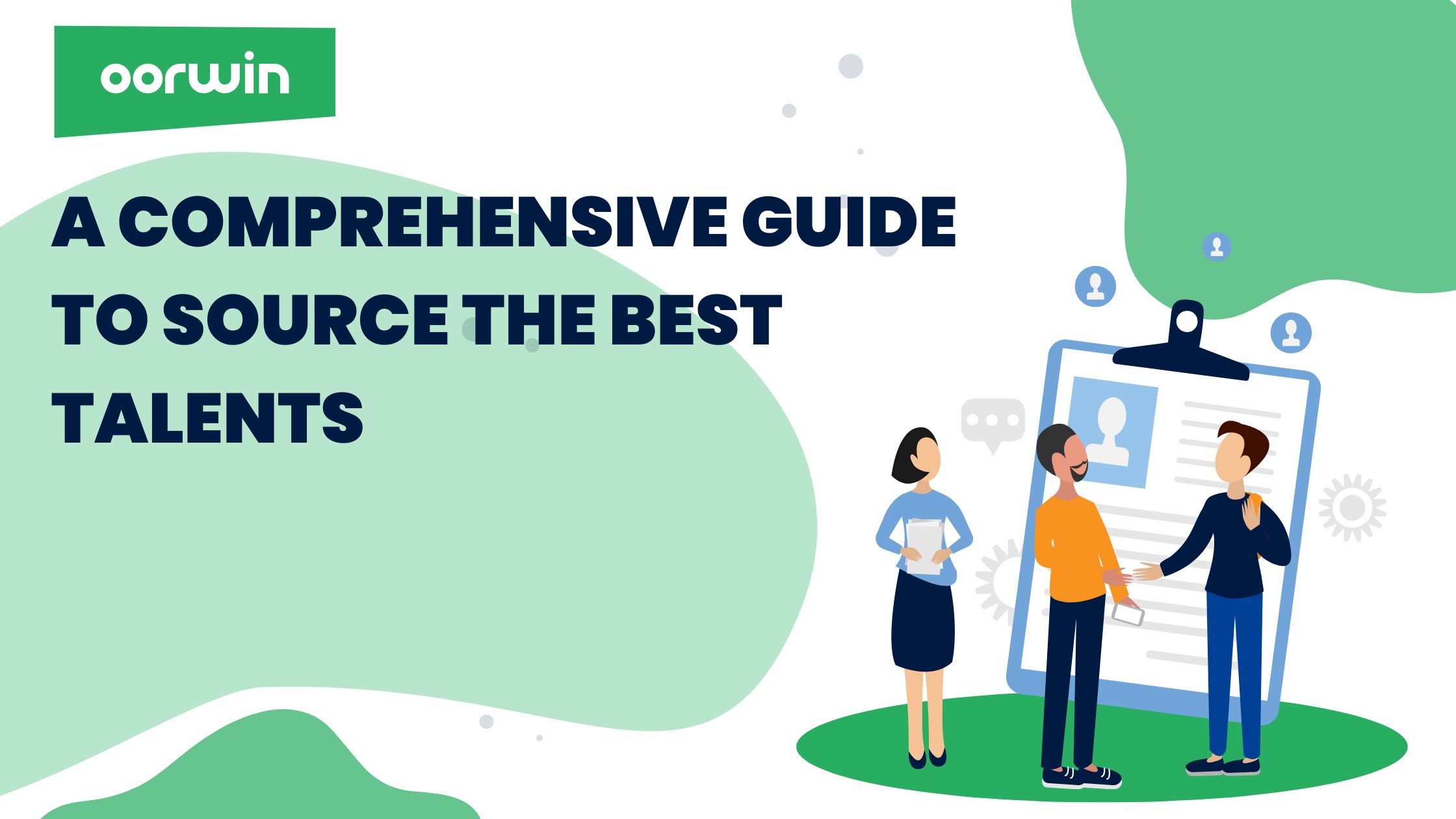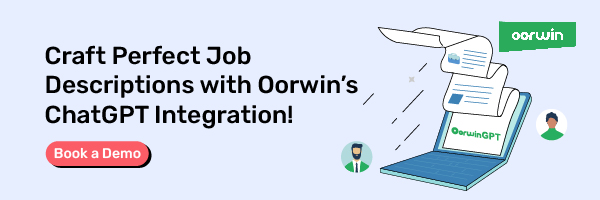A Comprehensive Guide to Sourcing Top Talent
Oorwin
2min read / 17 Feb 2023

Related Articles
How to Source Top Talent
Candidate Sourcing involves identifying and engaging with potential candidates who may be either passively or actively seeking new opportunities but have yet to apply directly to a job opening. This approach focuses on gathering critical details about these individuals, such as their names, proof of qualifications, and ways to contact them. How these sourced candidates are measured or tracked in terms of recruitment metrics differs from the methods used for candidates who apply directly to job postings.
When calculating the effectiveness of sourcing candidates, it’s essential to consider these metrics:
- Time to Hire: This metric should be evaluated from the first interview to the point where the candidate accepts the job offer. It’s crucial to note the number of messages required and the time taken to nurture a candidate, comparing the speed of their progression through the hiring stages with general applicants.
- Source-to-Interview Conversion Rate: Keep a close eye on the rate at which ‘pre-screened‘ sourced candidates are moving to the interview stage. This rate should typically be higher due to the pre-screening process. If you notice a decline in this rate, reassess and adjust your sourcing strategies.
- Source-to-Hire Conversion Rate: Tracking the origins of where hired candidates were sourced from is vital. This metric helps assess your sourcing channels’ return on investment (ROI) and candidate acquisition budget. By understanding which channels are most effective, you can allocate resources more efficiently and improve your sourcing strategy.
Challenges in Candidate Sourcing
Recruiting and sourcing candidates can often be challenging and time-consuming. Specific roles may have fewer applicants than anticipated or need more quality. When candidates don’t have the right skills or experience, the hiring process can take much longer than expected. Other obstacles that can arise include
- A lack of human resources skill sets: Many organizations need more HR professionals with the necessary skills to source candidates effectively. This includes expertise in modern recruitment technologies, understanding the current job market, and designing compelling job descriptions and candidate outreach strategies.
- A lack of understanding of candidate behavior and market trends: Keeping up with the latest trends in candidate behavior, such as preferences for work culture, communication styles, and job search methodologies, is crucial. A gap in understanding these trends can lead to ineffective recruitment strategies that fail to attract and source the right candidate.
- Difficulty identifying and connecting with passive candidates: Passive candidates are often the most valuable prospects, not actively seeking a new job but open to opportunities. However, identifying and engaging these individuals requires different strategies than active job seekers.
10 Effective Candidate Sourcing Techniques to Find the Right Talent
When sourcing candidates, it’s essential to understand the difference between sourcing and recruiting. This guide will provide you with the best sourcing strategies to help you find the ideal candidates.
Assess the Qualifications Needed for the Role
Understanding the qualifications required for a role often entails an initial meeting with the hiring manager. This meeting is crucial to align the necessary skills, experience, and qualifications expected from candidates. Additionally, examining several resumes together can be beneficial in identifying what an ideal candidate profile looks like.
Use Social Media Platforms
Most job seekers use social media platforms to find job information, so organizations should use them to promote their hiring needs. Social media platforms provide direct access to potential job seekers and allow recruiters to converse with passive candidates.
Prioritizing Passive Candidates
Organizations should pay close attention to passive job seekers in sourcing candidates who often have the most sought-after skills, qualifications, and experience. This requires expanding outreach to industry organizations, leveraging alumni networks, approaching key influencers, and building relationships with potential future hires.
Job Boards
Job boards can be an excellent way for organizations to list job vacancies and job seekers to find job opportunities. They provide a platform for employers and employees to meet each other, share information about their employment needs, and discuss the available candidates. Different job boards are available worldwide, serving different countries to provide recruiters with the perfect candidate per requirement.
Here are some job boards in India and the USA.
Employee Branding
Organizations should build an attractive employer brand and culture in attracting and sourcing candidates. An effective employer brand strategy provides an idea of what working with an organization is like and what to expect from a role.
Read more: Understanding the Importance of Employer Branding.
To save time and money, organizations should utilize candidate-sourcing software that can automate the process of sourcing, screening, and potentially onboarding candidates.
Artificial intelligence is revolutionizing candidate sourcing through automated and accurate matching, improving efficiency and reducing bias. AI tools can scour databases and the web for ideal candidates, rediscover previous applicants in your ATS by aligning them with current job requirements, and even update outdated resumes by gathering fresh public information.
Use Employee Referral
Employee referral programs leverage the networks of existing staff to identify potential candidates. By encouraging employees to recommend qualified acquaintances for open positions, companies can tap into a pre-vetted talent pool, often leading to hires who fit well with the company culture and have a shorter ramp-up time in sourcing candidates.
Networking and Industry Events
Attending industry events and networking functions is a strategic way to meet potential candidates professionally for sourcing candidates. These events provide opportunities to connect with passive candidates, gather industry insights, and promote your company’s brand, ultimately building a pipeline of industry-specific candidates for current and future hiring needs.
Plan your Candidate Outreach
Organizations should create a well-planned communication strategy that outlines the recruitment process and provides details about the role. This will ensure that recruiters effectively reach suitable candidates at the right time.

Revolutionize candidate engagement effortlessly – integrate WhatsApp Recruiting with Oorwin and elevate your recruitment game today!
Follow-Up
After connecting with a potential candidate, recruiters must ensure they follow up with emails, telephone calls, and tailored messages. Follow-up is essential to maintain relationships and to show the organization’s sincere interest when sourcing candidates.
Here are some tailored messages and email templates for recruiters.
Insights into Candidate Sourcing Statistics
Understanding candidate sourcing via pertinent statistics offers valuable perspectives for recruitment professionals. These figures highlight prevailing trends, behaviors, and methodologies, aiding in developing impactful sourcing tactics. Below is a summary of essential sourcing statistics.
Proportion of Hires Sourced Through Social Media:
Around 70% of hires use social media channels.
Recruiters actively seek out potential candidates on LinkedIn, Facebook, and X (previously known as Twitter) to engage with them and present job openings.
Proportion of Hires via Employee Referrals
Employee referrals are a highly effective sourcing strategy, accounting for approximately 30-50% of successful hires. Utilizing the networks of current Employees helps in discovering candidates who are a good match for the company’s culture.
Average Duration to Source a Candidate
It generally takes close to 10 days to source a candidate for a vacancy effectively. Streamlining sourcing procedures and employing efficient strategies are crucial in reducing the time required to pinpoint appropriate candidates.
Candidate Sourcing Strategies for Different Job Stages
In the talent acquisition landscape, sourcing candidates requires tailored strategies that cater to different job levels’ specific needs and experiences. From entry-level positions, where fresh talent is eager to start their careers, to mid-level roles requiring professionals with a solid foundation of experience, and up to executive-level posts, where strategic leadership qualities are paramount, effective sourcing demands a nuanced approach.
How to Source Entry-Level Candidates
Sourcing entry-level candidates requires a multifaceted approach, targeting those new to the job market or with limited work experience. Building partnerships with colleges and universities allows for direct engagement through career fairs and campus recruiting events, connecting with students eager for entry-level opportunities. Establishing internship programs within your organization creates a pipeline for nurturing talent offering hands-on experience to students and recent graduates. Leveraging online job boards and career websites, mainly those catering to entry-level positions, helps attract fresh graduates and those embarking on their careers. Social media platforms like LinkedIn, Facebook, Twitter, and Instagram are invaluable for showcasing your organization and the opportunities it offers.
How to Source Mid-Level Candidates
Sourcing mid-level candidates with a few years of experience requires leveraging various channels to tap into their professional networks and interests. This involves posting detailed job openings on job boards and career websites tailored for mid-level positions, engaging on professional networking platforms like LinkedIn, and participating in industry-specific events and conferences. Key strategies include partnering with specialized recruitment agencies, encouraging employee referrals, and connecting through professional associations and alums networks.
Additionally, utilizing social media, attending networking events, and collaborating with executive search firms can broaden the search. Keeping your company’s careers page updated with appealing job descriptions is crucial to attracting the right talent.
How to Source Executive-Level Candidates
Sourcing executive-level candidates demands a focused strategy, utilizing both traditional and innovative approaches. Partnering with executive search firms offers access to a network of vetted leaders, while industry events and professional associations provide platforms for direct engagement with potential candidates. Utilizing LinkedIn’s advanced search capabilities allows for targeted outreach, and exclusive roundtables or conclaves offer unique opportunities for interaction. Tapping into alum networks of elite universities and collaborating with industry experts can reveal hidden gems.
Additionally, leveraging specialized job portals, developing an in-house talent acquisition team, and considering candidates from competing firms are all critical tactics. This multifaceted approach ensures a comprehensive search for top-tier executive talent.
Candidate Sourcing vs Recruiting: What’s the Difference?
Candidate Sourcing vs. Recruiting is an important distinction because it’s what we do when hiring a new employee. Essentially, sourcing candidates is finding the right candidate for your company online.
Recruiting is more of a traditional job search—where you’re actively trying to find candidates who match your needs and interests. Sourcing can be done remotely (on your computer) or in person (at a career fair or networking event), but recruiting typically involves hunting down candidates in your local area.
Sourcing can be used for all positions, from entry-level to senior leadership. Recruiting tends to be more specific to certain jobs or industries.
Best Practices in Talent Sourcing: What to Do and What to Avoid
To conduct a talent-sourcing process that is both effective and adheres to ethical standards, it’s crucial to follow certain best practices while avoiding common pitfalls.
Dos:
- Maintain Professionalism: Always interact with candidates with the highest level of professionalism and respect, safeguarding your organization’s reputation.
- Utilize Employee Referrals: Tap into your employees’ networks by encouraging referrals, which can lead to finding candidates who are a great cultural fit.
- Personalize Communication: Address candidates individually, highlighting how their specific skills and experiences make them a good fit, to foster engagement.
- Offer Constructive Feedback: Provide valuable feedback to unsuccessful candidates, offering insights into areas for improvement and maintaining a positive image of your company.
- Develop a Talent Pool: Actively engage with potential candidates to build a reservoir of talent for future openings, ensuring a proactive approach to recruitment.
Don’ts:
- Avoid Generic Emails: Steer clear of impersonal, bulk emails. Personalized communication is key to demonstrating interest in each candidate.
- Refrain from Overselling: Present the job and company realistically without overstating benefits or opportunities to ensure expectations are met.
- Ensure Thorough Screening: Conduct comprehensive background checks to verify the authenticity of candidate information, ensuring a reliable hiring process.
- Prioritize Candidate Experience: The recruitment process should be a positive experience for candidates to uphold your company’s reputation and appeal to top talent.

How Oorwin Can Help for Sourcing Top Candidates
Oorwin provides a full-cycle recruitment solution, from candidate sourcing to engaging them throughout the hiring process. Achieve more incredible speed and scalability in hiring by matching and ranking candidates based on AI-generated insights and then having those candidates evaluated for relevance.

Source the best candidate that fits with your top-tier organization. Find the perfect fit for your organization with Oorwin today!
Frequently Asked Questions
What strategies can be used to source candidates?
Organizations should use strategies such as leveraging social media platforms, prioritizing passive candidates, utilizing job boards, building an attractive employer brand, utilizing candidate sourcing software, planning outreach, and following up to source top candidates effectively.
How can employers create an effective employer branding strategy?
Employers can create an effective employer branding strategy by creating a compelling mission statement, crafting job descriptions highlighting the organization’s culture and values, utilizing career blogs and webinars to engage applicants, and leveraging social media platforms.
What are sourcing Tools?
Sourcing tools are software programs and platforms that enable recruiters to source candidates more effectively and efficiently. These tools help recruiters narrow the pool of applicants, prioritize candidates, and create strong relationships throughout the recruitment process.
Popular Articles..
Blog

2min read / 25-Jun-2025
Master Effective Interview Techniques with Oorwin: A Step-by-Step Recruiter’s Guide
Blog
Blog
Get the latest Oorwin releases, updates, success stories & industry news
 Back
Back
